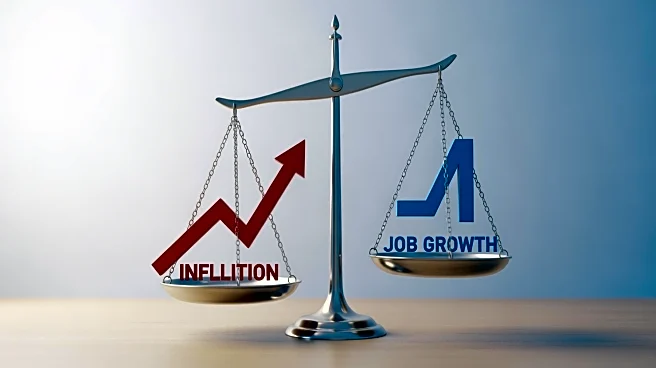What's Happening?
Consumer sentiment in the United States has plummeted to a three-year low, nearing the lowest point ever recorded by the University of Michigan. This decline comes one month into the ongoing government
shutdown, with widespread pessimism about personal finances and anticipated business conditions affecting Americans. The November survey reported an index of consumer sentiment at 50.4, marking a significant 6.2% drop from the previous month and a nearly 30% decrease from the same period last year. Economists had anticipated a slight increase, predicting a reading of 54.2. The sentiment decline was observed across various demographics, including age, income, and political affiliation, except among those with substantial stock holdings, who have benefited from the strong performance of big tech companies, particularly in artificial intelligence.
Why It's Important?
The drop in consumer sentiment is significant as it reflects broader economic concerns among Americans, potentially impacting consumer spending, which is a major driver of the U.S. economy. The sentiment decline suggests that consumers are worried about the economic repercussions of the prolonged government shutdown. This could lead to reduced spending during the holiday season, despite forecasts of a trillion-dollar Christmas with sales expected to grow up to 4.2% in November and December. Additionally, the survey indicates rising inflation expectations, which could further strain household budgets. The sentiment regarding unemployment is particularly concerning, with a majority of households expecting an increase in unemployment over the next year, which historically precedes negative outcomes for the job market.
What's Next?
The ongoing government shutdown has halted the release of key economic data, including the monthly jobs report, forcing economists to rely on private sources for insights into the labor market. These sources suggest that job seekers are facing longer periods of unemployment in a market characterized by low hiring and firing rates. The sentiment survey was conducted before Election Day, and its results may have been influenced by a change in methodology, switching from phone-based to online sampling, which could have introduced a structural break leading to more negative results. As the shutdown continues, the economic outlook remains uncertain, with potential implications for consumer behavior and broader economic stability.
Beyond the Headlines
The shift in survey methodology from phone-based to online sampling may have affected the results, introducing a structural break that could skew sentiment readings. This methodological change highlights the challenges in accurately gauging consumer sentiment during periods of economic uncertainty. Additionally, the sentiment decline underscores the interconnectedness of political events, such as government shutdowns, with economic perceptions and behaviors, emphasizing the need for stable governance to maintain consumer confidence.












